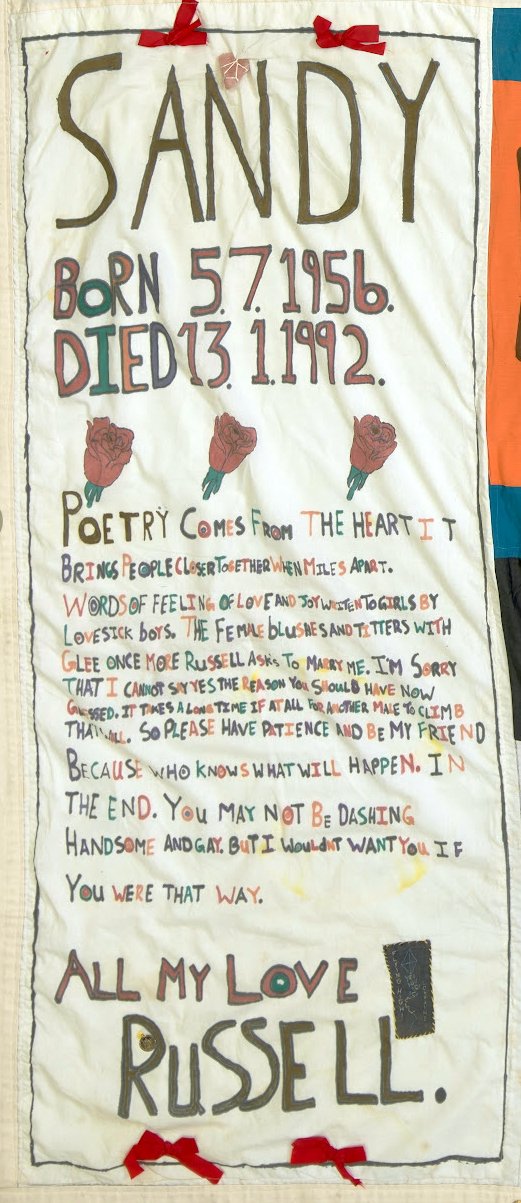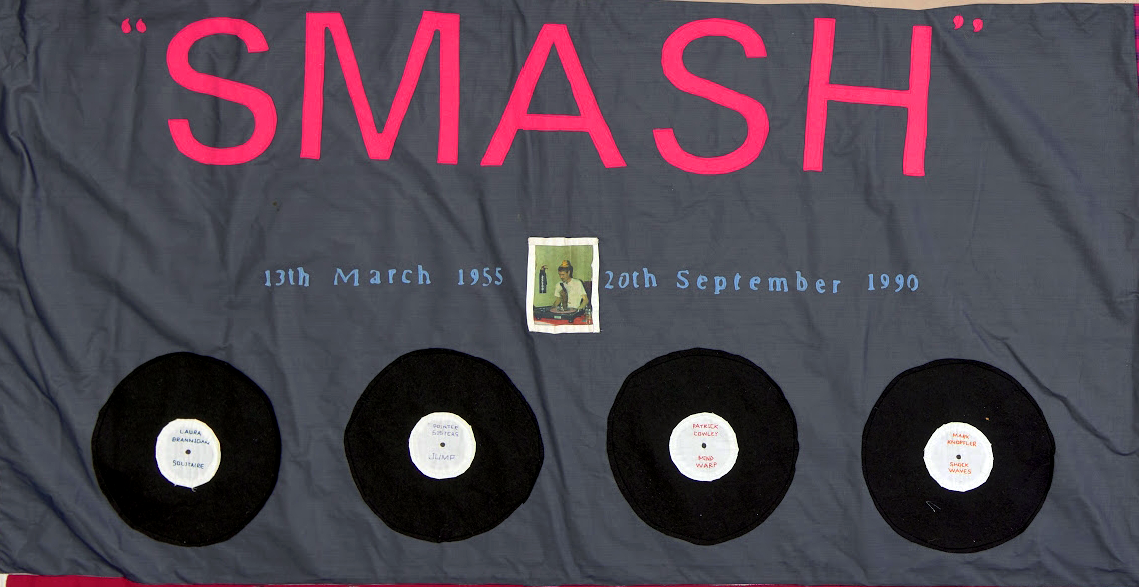UK AIDS Quilt: Behind the Stitches
After visiting the UK AIDS Memorial Quilt on display at the Turbine Hall at the TATE in the summer of 2025, I found myself deeply moved by the creativity and craftsmanship evident at all levels, alongside the poignant individual stories embedded in each panel. Whether driven by curiosity or the absence of a permanent memorial commemorating those lost in the AIDS pandemic, I found myself repeatedly pondering who these individuals were and how life had treated them.
This reflection led me to research various quilts that particularly caught my eye—especially those that displayed only a forename. This choice, whether intentional or a reflection of the fear surrounding openly memorialising loved ones with their full names, added layers of mystery and anonymity that invited further contemplation on the personal and societal impact of the epidemic, whilst also learning more about who they were.
Roy Brian Astle was born on the 10th of August 1960 in Manchester, contrary to the 12th as stated on the panel. He was the fifth of nine children born to Brian Oswald Astle and Jean Oliver. His siblings included Adriane, Paula, the twins Brian and Kim, himself, followed by Jean, Paula, and additional twins Colin and Wendy, who were born in the spring of 1971. Tragically, their father Brian Oswald passed away on New Year’s Day 1971 at the age of 35, leaving Roy, then just 10 years old, to grow up without his father.
Manchester News: 5 Jan 1971
Image courtesy of UK AIDS Memorial Quilt - AIDSquiltUK.org
Before Roy moved to Brighton, his life as a young man had become increasingly difficult. News reports suggested that he was involved in a troubled relationship characterised by frequent arguments and instances where he was threatened with a knife. During one particularly volatile dispute, a man he was living with, visibly intoxicated, brandished a knife and then climbed onto a balcony ledge. When Roy tried to prevent him from falling by pulling him back, the man tragically lost his balance and fell to his death. Following this incident, Roy found himself facing a court case, charged with manslaughter.
It appears the jury made the right decision in clearing Roy of any wrongdoing. Although we were not present, the circumstances described suggest the situation was problematic, with Mr Ashcroft having placed himself in danger while intoxicated, leading to a regrettable loss of footing and a subsequent fall.
For reasons not fully disclosed, Roy relocated to Brighton, Sussex, perhaps seeking a fresh start. Little is known about his time there, but it is hoped that the podcast’s reach might encourage those who remember Roy to come forward. What is known, from the quilt dedicated in his memory, is that Roy tragically lost his life to AIDS on 10th August 1992, aged just 32.
Photos: Roy, stitched upon his quilt [UK AIDS Memorial Quilt]
The quilt dedicated to Andrew was lovingly crafted by Ajay, a fellow Oxford student and Andrew’s secret lover. Their relationship was kept hidden, as they were not openly homosexual during their time at university. Ajay detailed the quilt’s design as a deeply personal tribute to his ‘first and only love,’ incorporating a cassette tape featuring Andrew’s favourite songs.
Near the bottom, the quilt displays the friendship band Andrew gave Ajay when they first met as friends at Oxford. Included within the fabric is a sealed envelope containing a poem Ajay had intended to send Andrew but never did, having sadly heard of Andrew’s death before he could. The quilt also holds the necklaces they exchanged and the ring Andrew gave Ajay on their first anniversary, each piece symbolising the profound connection and enduring love between the two.
Ajay shared that Andrew’s parents were not supportive of either their relationship or Andrew’s homosexuality, nor were they accepting of his AIDS diagnosis. It appears that Andrew was taken back to his parents’ home for the remainder of his illness where Ajay wrote to Andrew. Ajay also mentioned that the tape contains songs played at Andrew’s cremation, which may indicate that Ajay was permitted to attend the service, despite the earlier lack of support from Andrew’s family.
Image courtesy of UK AIDS Memorial Quilt - AIDSquiltUK.org
Ajay promised—though it sounded more like a demand—that Andrew’s surname would not be included in the creation and submission of the quilt. Respecting this, Ajay kept his word meticulously, crafting a heartfelt tribute that honoured Andrew's memory without revealing his full identity. Tragically, just four weeks after sending his lovingly made quilt to the Names Project, Ajay took his own life, leaving behind a profound sense of loss and a testament to the weight of those ‘affected’ and not ‘infected’.
1989: Ajay Chotai
Ajay’s full name, Ajakumar Mansurhal Chotai, stands out as not particularly “Kenyan” despite what the press had reported. A closer look reveals that his forename, ‘Ajakumar’, is of Sanskrit origin, rooted in Indian culture, while his surname ‘Chotai’ is commonly found in Indian communities, particularly from Gujarat and Rajasthan.
This heritage sheds light on the ink-stamped symbols found on Andrew’s quilt, which appear to be a deliberate reference to Hindu iconography. Given Ajay’s background and likely connection to Indian faith or belief systems, these symbols seem an accessible and meaningful inclusion rather than a coincidental or misplaced detail.
Additionally, I found an article on AIDS services in Leicester from 1989, where Ajay was a volunteer a year prior to Ajay beginning his engineering studies at Oxford University, where he would later meet Andrew. Within the article was a group photograph that notably included Ajay, highlighting his early involvement in community health initiatives during a critical period of the AIDS epidemic. This discovery sheds light on a lesser-known aspect of his life before his academic pursuits, revealing a commitment to social causes that parallels his intellectual endeavours. It also underscores how attuned he was to treating others with love and kindness, fostering a sense of compassion that would define both his personal and professional life.
While there is no official birth record for Ajay in the UK, it is documented that he commenced his education at Glebe Primary School in Harrow, London, at the age of four [Reception/First Year]. This detail suggests that he likely arrived in the UK as a very young child, possibly even as a baby, accompanied by his parents or family.
I feel Andrew’s life should not be hidden away in secret, especially as society has become increasingly accepting of both homosexuality and HIV/AIDS. During my research, I prioritised verifying the accuracy of the information I uncovered, and considered the sensitivity of reaching out to any surviving relatives. This process led me to reflect on the necessity of fully identifying Andrew, particularly now that his story, alongside Ajay’s, is commemorated through the quilt. The memorial itself serves as a powerful testament to their lives, perhaps allowing for a focus on collective remembrance rather than individual identification.
Image courtesy of UK AIDS Memorial Quilt - AIDSquiltUK.org
Elaine Grieve was born on 29th March 1969 in Bellshill, Strathclyde, Scotland, to Moira Creighton and Gavin Grieve. She was the youngest of three siblings, with an older sister, Kim, and an older brother, Paul.
Little is known about Elaine, other than that after leaving Scotland, she joined her sister in Islington, London, where she worked as a waitress. Having seen a photograph* of Elaine—a striking young woman with bright pink spiky hair and clothing evocative of the punk and new age traveller scene—she would undoubtedly have blended seamlessly into the vibrant Islington culture of the time. The area was then a hub for artists, punks, designers, and creatives, making it a fitting backdrop for someone of Elaine’s distinctive style and alternative edge.
Given the lovingly made memorial in her memory on the AIDS quilt, it is clear that Elaine’s premature death was a consequence of AIDS. Elaine passed away on 16th March 1994, aged just 24, at 11 Lyndhurst Gardens in the London Borough of Camden, with her sister Kim by her side. This address is still home to the Marie Curie Hospice, and to which Elaine’s death was officially recorded as resulting from Acquired Immunodeficiency Syndrome.
Nine days after her passing, a noticewas placed in the Scottish newspaper, the Lanark and Carluke Advertiser, commemorating her life whilst announcing her passing.
*We would only ever share personal photographs with the explicit permission of the owner, respecting their privacy and wishes. We hope to receive a response from Elaine’s family in the future.
Mark Freeman
Mark Simon Anthony Griffiths Freeman was born on 11th May 1961 in Winchester, the youngest of four children to Leslie Freeman and Peggy Boorman.
The quilt dedicated to his memory reflects some of his early accomplishments as a dancer with The Royal Ballet, capturing the grace and discipline that marked the beginning of his artistic journey before he transitioned into acting. His quilt serves as a poignant tribute to his life, career and the enduring legacy he left in both the worlds of dance and performance.
Mark left the Royal Ballet to turn his hand to acting, adopting the stage name ‘Myles Freeman’ as noted on his quilt. Despite showing great promise in his new career, his life was tragically cut short when he passed away due to AIDS-related complications on 26th January 1993. He was only 31 years old, a poignant reminder of the many talented individuals lost to the epidemic during that period.
Quilt: Mark Freeman - UK AIDS Memorial Quilt
Denny Williams, born Dennis Anthony Williams on 25th August 1965 in Birmingham, was the youngest of seven children to William Williams and Kathleen McGuinness.
With a mix of heartfelt obituaries and family notices, the profound sense of loss following Denny’s passing due to AIDS-related complications was deeply felt by all who knew him. His quilt, lovingly crafted by his partner of over six years, Roy, stands as a tangible symbol of their enduring bond. Adorned with verses of poems, inspirational quotes, and the cherished lyrics of the song they shared—‘Cherish’ by Kool and the Gang—the quilt encapsulates the pairs love, the depth of Roy’s love and the lasting impact Denny had on his life.
QUILT: Denny Williams - UK AIDS Memorial Quilt
QUILT: Tom Dwyer - UK AIDS Memorial Quilt
At Home: Tom (Credit: UK AIDS Quilt)
Thomas Simon Peter Dwyer was born on the 7th February 1959 in Blythswood, Glasgow, Scotland. He was the youngest of two children, with an older sister of two years, Serena.
The creator of Tom’s lovingly made memorial quilt also included a photograph [Right - courtesy of the UK AIDS Memorial Quilt Archive] and a detailed letter recounting Tom’s later life, his passing, and his heartfelt wish to reconnect with his sister Serena, who lived in Leeds.
Despite this strong desire, Tom felt that his AIDS diagnosis was not the right time to burden her with the news, and so he chose to keep his distance. You can read the letter here
Photo of Tom upon the Quilt
Tom passed away peacefully on 28 July 1992 at 01:30 am, aged 33. According to the creator of his quilt, Tom had spent a significant spell in hospital. Becoming restless, he requested to be taken home. Upon his return, despite his illness, he set about planning his own funeral and the celebration that would follow. At the time of his passing, he was residing at 56 Loughborough Road, London, located between Oval and Brixton—a detail thoughtfully stitched into his quilt. Tom was laid to rest at West Norwood Cemetery.
The quilt dedicated to the memory of Sandy Kane is reported to be the first quilt commemorating a woman to be added to the UK AIDS Memorial Quilt, according to Bradford’s Telegraph & Argus in July 1992, at a time when public acknowledgement of women affected by HIV/AIDS was rare.
The quilt was lovingly made by Russell Conlon, who met Sandy — originally from Canada — through a dating magazine; their first meeting was on Valentine’s Day 1988 in London, where Sandy, having moved from Canada in 1986 at the age of 30, lived and worked for the government.
On that date in 1988, when fear and prejudice often felt more contagious than the virus itself, Sandy told Russell she was living with HIV. Russell later told the Telegraph & Argus newspaper, “..when I met Sandy I didnt care what was going on inside her. I was interested in her as a person”, a simple, defiant refusal to let diagnosis define humanity.
QUILT: Sandy Kane - UK AIDS Memorial Quilt
Richard ‘Richie’ McMullen endured a troubled childhood under strict Catholic parents and an abusive father, which pushed him into precarious circumstances early on. By his own admission he was working as a “rent boy” in his early teens, first on the streets of Liverpool and then, after moving to London at 15, in the capital’s “meat rack”. Desperate to change course, he enlisted in the armed forces, but his attempts at reform were undermined by further trouble that culminated in a robbery conviction.
But Richie didn’t give up: he retrained as a mental health nurse, earned a counselling degree and devoted himself to campaigning for legal reform on male rape, while working with London’s rent boys alongside Centrepoint to help establish a youth hostel; he went on to found Streetwise, a charity supporting rent boys, and later co‑founded Survivors, which began as a helpline for victims of rape.
Richard also went on to write and publish four books: Living With HIV (1988), Enchanted Boy (1989), its sequel Enchanted Youth (1990) and the academic work Male Rape (1990). These publications established him as a forthright voice on subjects that were then little discussed in public, combining personal testimony, advocacy and scholarly analysis. Yet despite the courage and care of his output, the press wasted no time in attempting to vilify him, seizing on controversy around his earlier lief to cast him in reductive, sensational terms rather than engaging with the substance of his work.
QUILT: Richie McMullen - UK AIDS Memorial Quilt
Philip Maurice Tolson was born on 13th March 1955 in Bermondsey, London, and was the youngest of three boys, arriving into the world weighing 9lb 7oz. He was the son of Henry Tolson and Constance Clark, a family rooted in the working-class heart of Bermondsey, South London.
Philip was living on Agate Road, Hammersmith, West London. He passed away on 20th September 1990, aged just 35, at Westminster Hospital. His death was recorded as resulting from pneumonia related to HIV and progressive skin cancer, likely Kaposi’s sarcoma.
Philip Tolson [Credit: Philip Tolson Estate]
QUILT: Philip Maurice Tolson - UK AIDS Memorial Quilt
QUILT: ‘SMASH’
This photograph sits at the centre of Philip’s lovingly made quilt, its image hinting that he either worked as a DJ or kept a vinyl collection fit for spinning at parties and functions.
The careful stitched quilt and the inclusion of this photograph makes it clear that music was not merely background noise for Philip ‘SMASH’ but a lived passion; whether he mixed at events or cherished albums for their tactile warmth, the quilt becomes a shrine to that devotion. The choice to place the Vinyl discs in craft form at heart of the quilt, surrounded by fabric echoes of rhythm and groove, speaks of someone for whom vinyl was both craft and comfort.
Any third-party copyright material has been accessed through paid membership or incurred an administrative cost. Material has been used under the ‘fair use’ policy for the purpose of research, criticism and/or education, especially around the topic of HIV/AIDS. There has been no financial/commercial gain. If a credit is missing please get in touch.




































































































